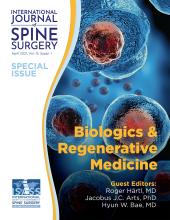ABSTRACT
Background: Back pain is a common chief complaint within the United States and is caused by a multitude of etiologies. There are many different treatment modalities for back pain, with a frequent option being spinal fusion procedures. The success of spinal fusion greatly depends on instrumentation, construct design, and bone grafts used in surgery. Bone allografts are important for both structural integrity and providing a scaffold for bone fusion to occur.
Method: Searches were performed using terms “allografts” and “bone” as well as product names in peer reviewed literature Pubmed, Google Scholar, FDA-510k approvals, and clinicaltrials.gov.
Results: This study is a review of allografts and focuses on currently available products and their success in both animal and clinical studies.
Conclusion: Bone grafts used in surgery are generally categorized into 3 main types: autogenous (from patient's own body), allograft (from cadaveric or living donor), and synthetic. This paper focuses on allografts and provides an overview on the different subtypes with an emphasis on recent product development and uses in spinal fusion surgery.
Footnotes
Disclosures and COI: The authors received no funding for this study and declare no conflicts of interest.
- This manuscript is generously published free of charge by ISASS, the International Society for the Advancement of Spine Surgery. Copyright © 2021 ISASS







